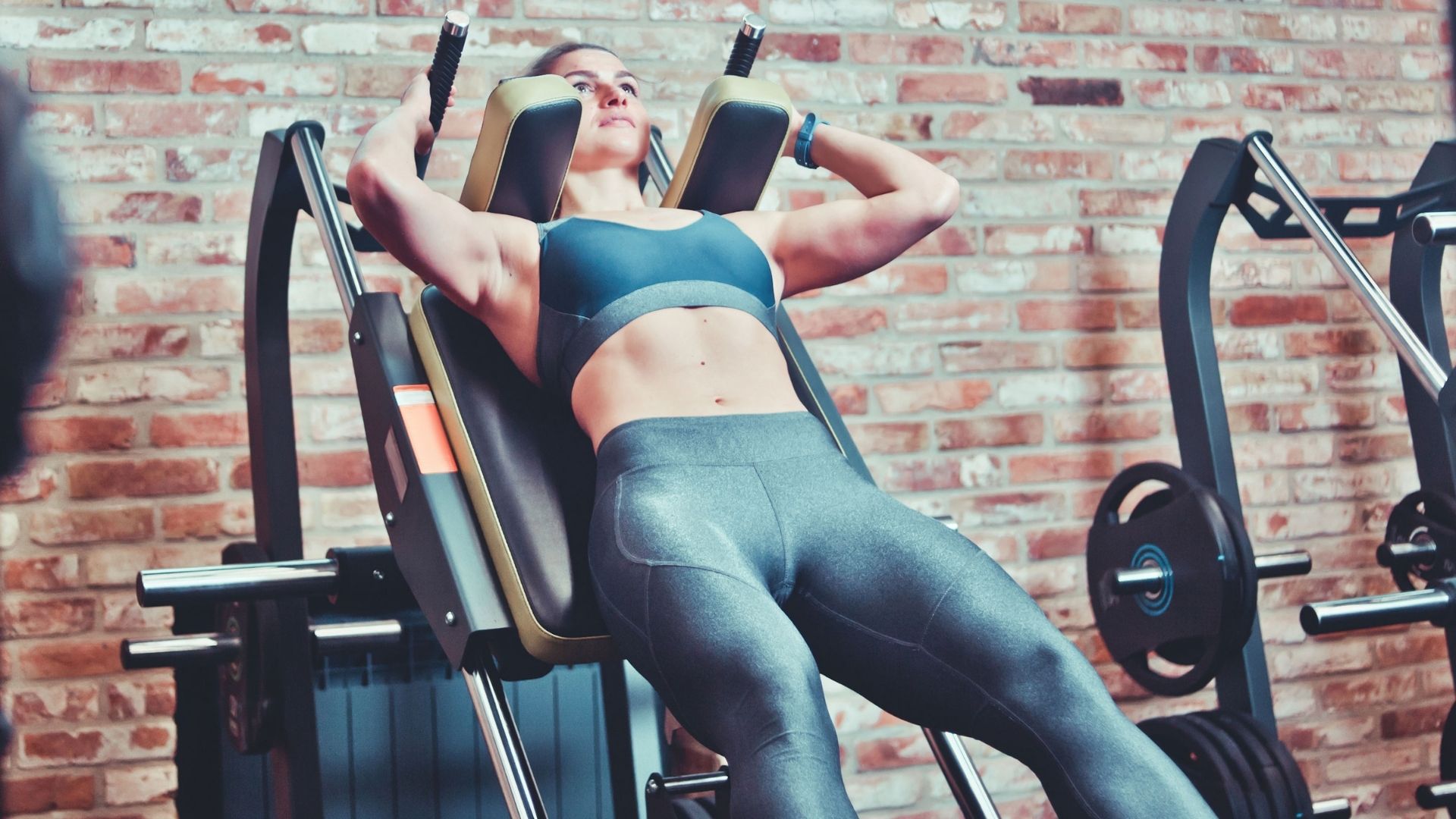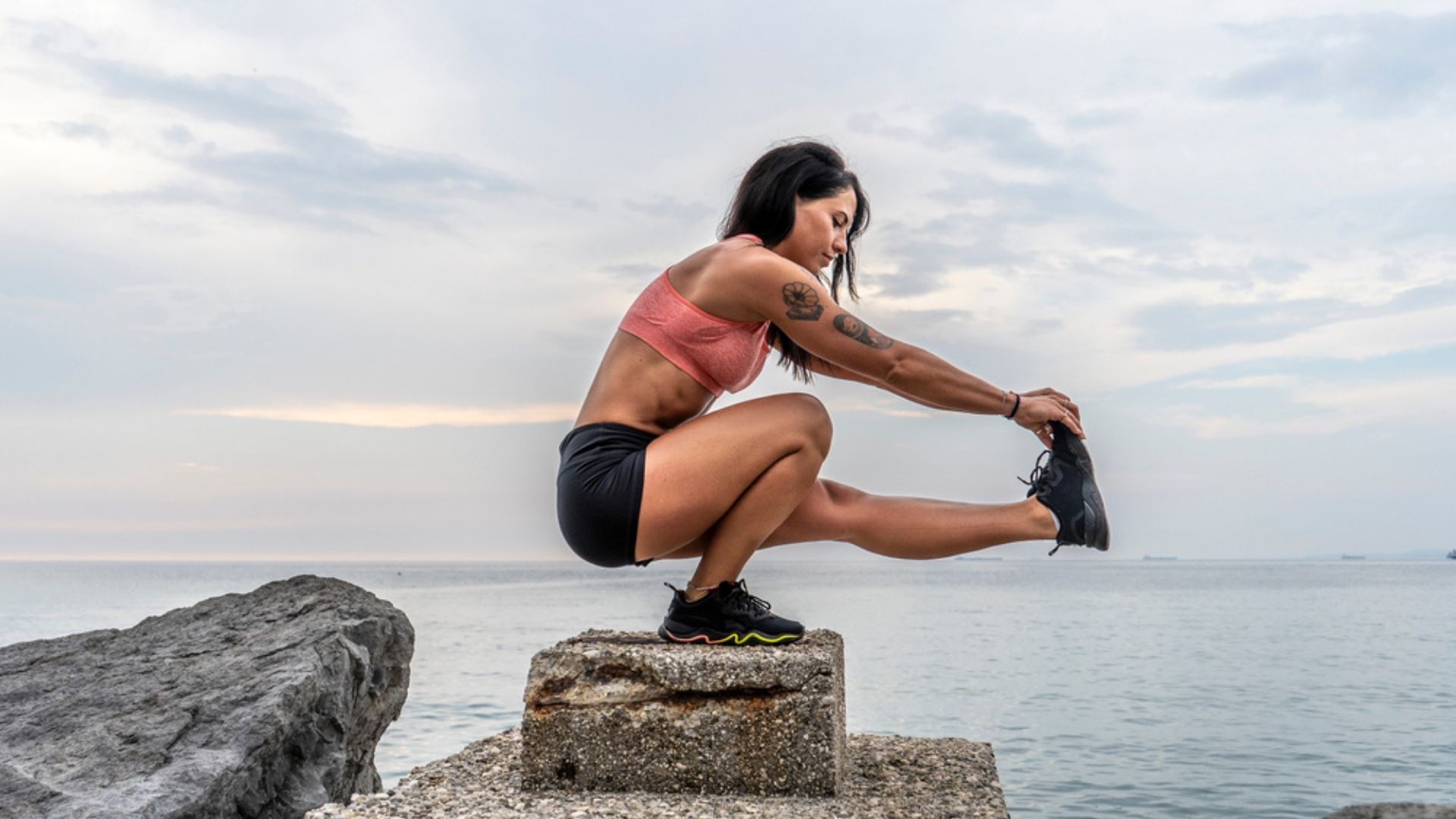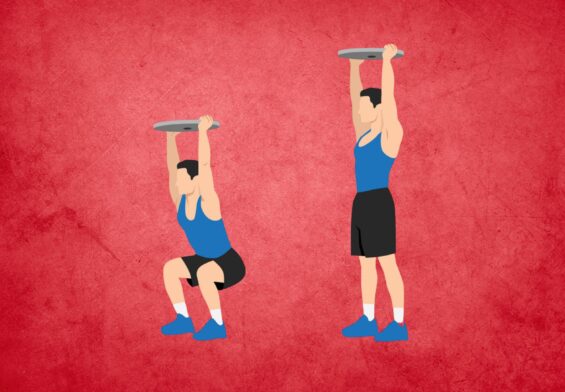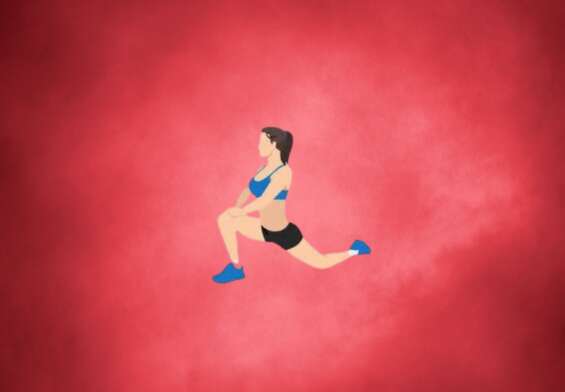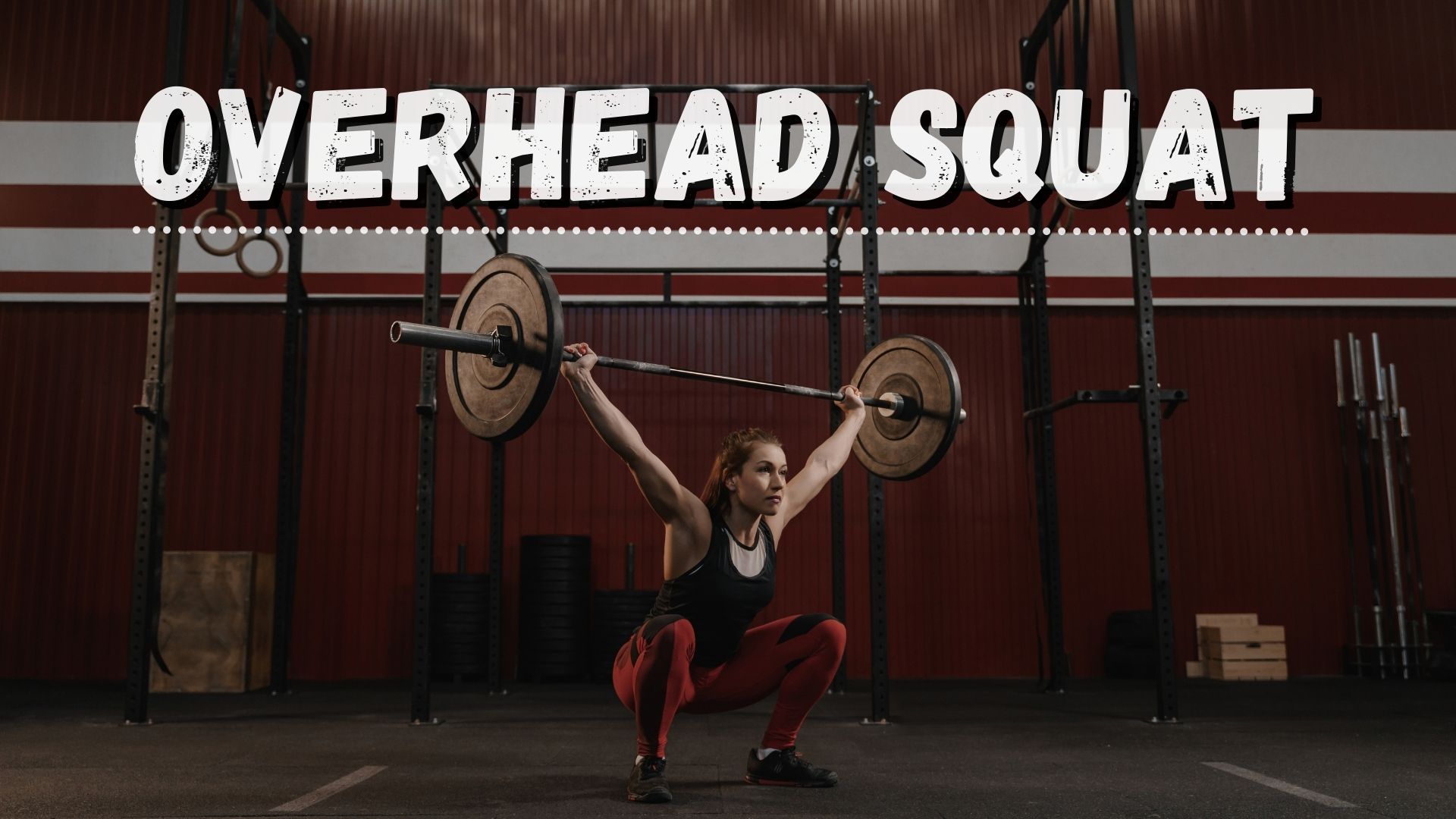
Overhead Squat: Build Strength and Improve Mobility
The overhead squat can be one of the most effective exercises for targeting your entire body.
It can improve strength, flexibility, and mobility, transferred to other exercises or everyday life.
The problem with the overhead squat is that it often points out weaknesses in a squat.
This includes hip mobility and ankle mobility.
It can be awkward to do the exercise, especially if you are just learning the mechanics.
It has many health benefits that will benefit your body.
What Is An Overhead Squat?

An overhead squat, a more advanced form of squat, works for all muscle groups.
Lift a weighted overhead bar and lower it into a squat position to perform overhead squats.
Try overhead squats for the first time with an unweighted or PVC pipe.
Purpose
The most basic snatch receiver position is the overhead squat.
This exercise can be used as a part of the learning process for the snatch (learning how to receive), a strength-building exercise for the trunk and upper body, and a mobility drill to improve the lifter’s bottom position during the snatch.
How To Do An Overhead Squat
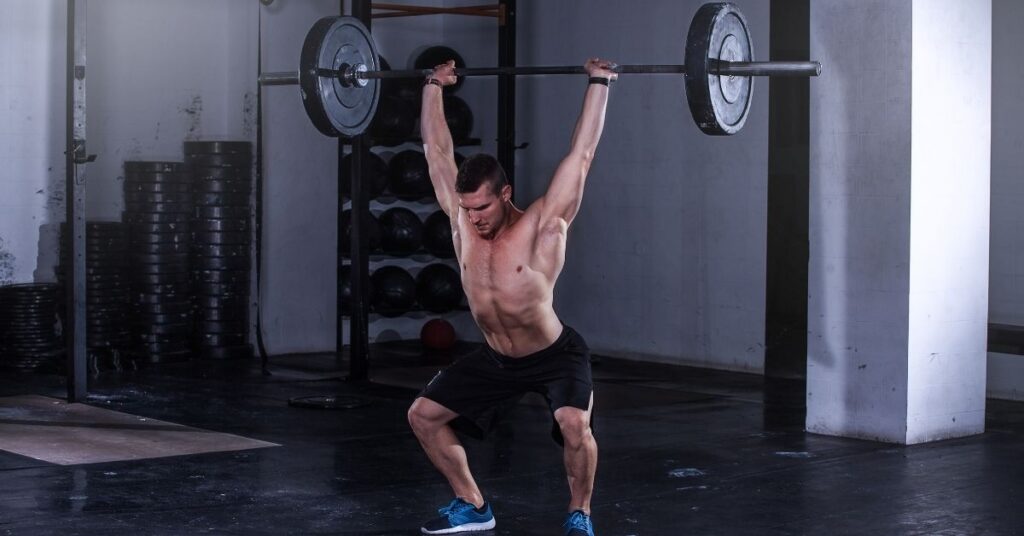
A barbell is required to perform an overhead squat.
You may need plates weights to increase resistance depending on your strength, mobility, comfort level, and ability to perform the exercise.
Standing tall with your feet shoulder-distance apart, keep your toes slightly inward.
The barbell should be placed across your back, with your traps resting on it.
Place your hands slightly wider than usual for a back squat to ensure that your hands are closer to the plates.
To stabilize your spine, take a deep inhale and brace your core.
Keep your torso straight (don’t tilt forward from your hips), and bend your knees.
Then, drop your hips a bit. As you extend your hips and knees, lift the barbell above your head.
Lock your elbows at both ends.
Bend your wrists slightly to prevent the barbell from rolling over your thumb joint.
You should check to ensure that the barbell is not positioned too far above your center feet.
It should not be too far forward or backward.
This can cause problems when you squat.
This is your starting position.
To perform the overhead squat:
- Your hips should be slightly shifted, and you should start to bend your knees. Your core should be tight, and your elbows extended fully. It is important to keep your chest high, your eyes straight ahead or slightly angled towards the sky, and your body as straight as possible when squatting down. You can also lose balance if you lean forward towards your hips. The weight should be stacked directly above your center feet throughout the squat. As you squat, inhale.
- Depending on your mobility, squat as low as possible while keeping control. You can extend your knees slightly beyond your toes at the bottom of this exercise. Just make sure that your knees are aligned with your feet and not bending inward.
- Push through your feet, using your quads, glutes, and core, to fully extend your hips and knees. As you stand, exhale. Keep your knees slightly bent to align with your toes as you perform the movement.
- Do a complete set. Next, bend your elbows to return the barbell to your shoulders. Then, safely rack the barbell.
5 Advantages Of Overhead Squats
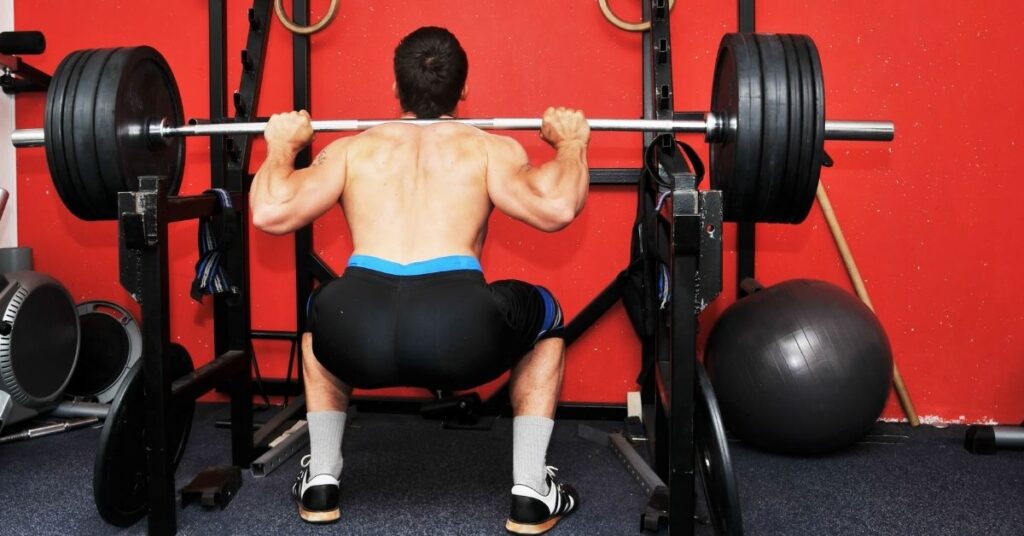
Take a look at the many benefits of overhead squats.
#1 Overhead Squats Can Improve Your Overall Strength
The overhead squat activates your upper body muscles like your triceps or deltoids.
It also activates your lower body muscles, including your hamstrings and adductors.
#2 Lifting Your Arms Overhead Can Improve Mobility
Overhead squats improve ankle, hip, and shoulder joints by hinging multiple joints.
#3 Overhead Squats Engage Your Core
Your core muscles are activated by overhead squatting, which acts as stabilizers.
This benefit can be unlocked by keeping your core engaged throughout the entire range of motion.
#4 Overhead Squats Can Improve Your Squat Form
By focusing on overhead squats, you can identify any inadequacies in your squatting; as a training exercise for other squat exercises such as the front squat and goblet-squat, practice overhead squats.
#5 Overhead Squats Can Be Used In Many Ways
An overhead squat can be a great exercise to do at home.
You can also do this exercise with a dumbbell or kettlebell overhead if you don’t own a barbell.
Muscles Worked In Overhead Squat
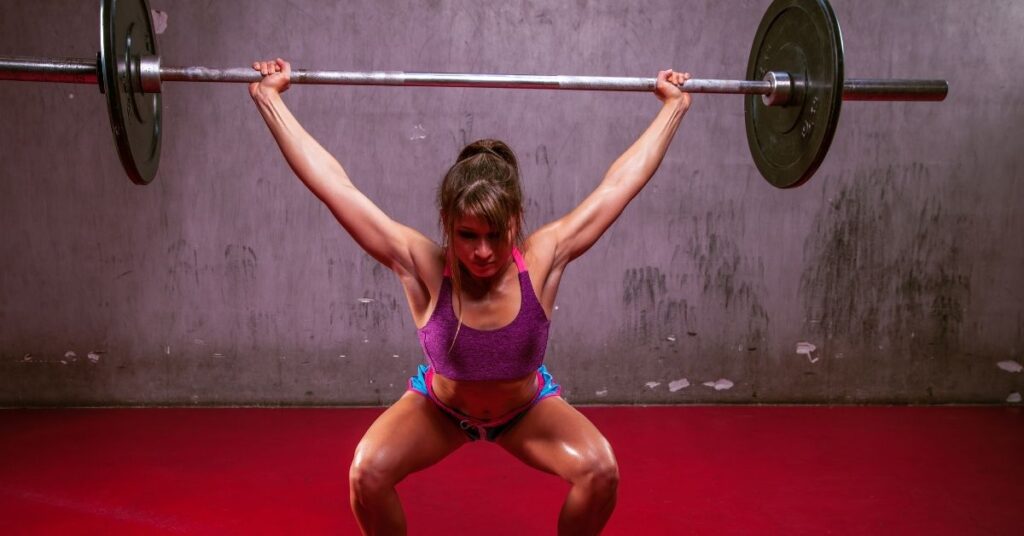
The overhead squat, a total-body exercise, challenges the lower body and the upper back and shoulders.
The overhead squat targets the following primary muscle groups:
Shoulders
The overhead squat is a major part of the shoulders’ role.
They must keep the barbell overhead with the help of the triceps and remain stable throughout the movement.
To stabilize the overhead load, the shoulders perform an isometric function.
Quadriceps
The overhead squat is a major task of the quadriceps.
The vertical torso positioning requires that the lifter goes into deeper knee flexion to stay in place.
This means they must elevate with greater knee extension to remain in position.
Trapezius
When the overhead load is lifted, the trapezius muscles (upper traps) provide stability and strength.
The shoulders can become too stressed if the trapezius muscles (upper traps) are not engaged properly.
The overhead squat traps must be engaged by the lifters.
Core
Stabilizing a lifter involves the abdominals, obliques, and lower back.
They support the overhead load, move through the entire range of motion in the overhead squat, and remain braced and steady in the overhead sit.
Who Should Do Overhead Squats?
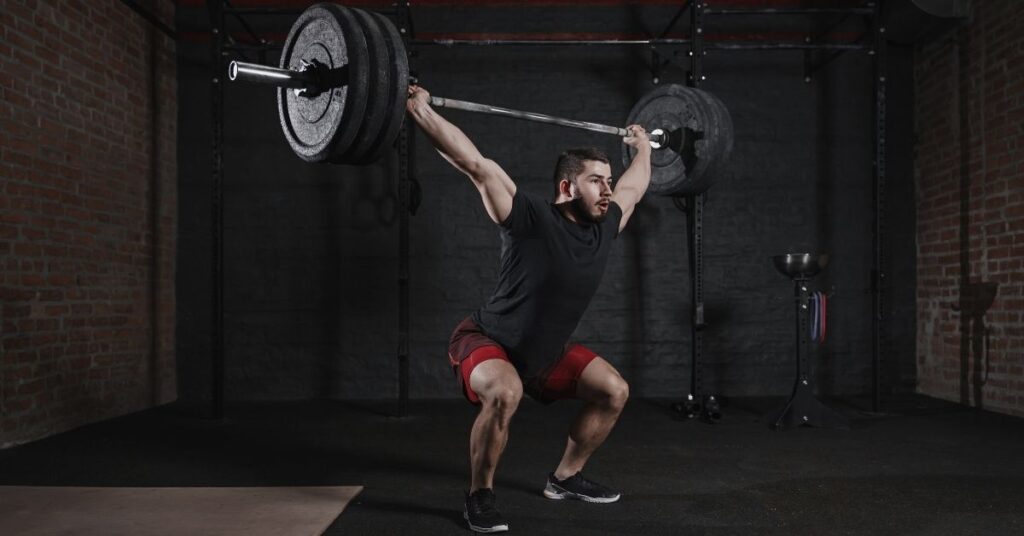
The overhead squat is a great exercise for all fitness and strength levels.
These movements can be beneficial for the following groups:
Overhead Squat To Strength Athletes
The overhead squat is a great way to help strength athletes improve shoulder strength and stability.
It can also enhance squat patterning and increase ankle, knee, and hip mobility.
Although this exercise isn’t specifically for powerlifting or strongman, it can help increase movement integrity, core strength, and shoulder stability.
Overhead Squat For Weightlifters
The overhead squat plays a crucial role in the snatch.
The overhead squat is a crucial movement for the snatch.
It increases a lifter’s ability to take a low, stable position as a receiver.
It can improve their ability to quickly and confidently get in a snatch position.
This movement can also help improve squat patterning in other squatting movements.
Overhead Squat For Crossfit/Competitive Fitness Athletes
CrossFit and fitness professionals can improve their weight, overhead strength, and squat positioning through mastering the overhead sit.
This is a fundamental squatting move.
A person with difficulty snatching (full-snatch) whose power exceeds 85-90% could have poor overhead squatting skills.
Overhead Squat For General Fitness
The overhead squat, a total-body movement, can improve upper back, shoulder, and core strength.
It also reinforces proper squatting techniques.
An overhead squat is a test of your ankle, knee, hip, and shoulder mobility, as well as midline control.
Overhead Squat Variations

Here are three variations of overhead squat that coaches and athletes can use to keep their training diverse and progressive.
Pause Overhead Squat
The overhead pause is similar to the other variations of pause squat.
It can help increase core stability, control, balance, and control in the bottom half of the squat.
It will also teach lifters to keep their core engaged and work with the upper back muscles while paused.
This will challenge them to improve concentric strength when they get out of the squat.
Tempo Overhead Squat
Tempo overhead squats are similar to all other tempo variations.
They can be done at specific cadences to increase tension, improve lifter’s movement control at certain positions and address any technical issues in overhead squat movements.
Clean Grip Overhead Squat
Clean grip overhead squat refers to an overhead squat with a tight grip (also possible with a “jerk grip”), rather than a grip that is wider like one taken in a “snatch.”
A narrower grip means more overhead mobility.
Additionally, lifting lifters who want to maximize their upper back strength during the squat will find it useful to narrow the grip.
Overhead Squat Alternatives

Here are three HSPU options that coaches and athletes can use for explosiveness.
Single Arm Dumbbell With Overhead Squats
A single-arm dumbbell/kettlebell overhead squat can improve unilateral overhead stability, core strength, and functional fitness.
It can also help lifters train the same muscle groups and joint actions while increasing movement and stability in slightly differing patterns.
Overhead Lunge
You can make the overhead lunge with any lunge movement, including walking, reverse, Bulgarian split, squat, and others.
This movement can often help lifters with difficulty assuming an overhead squat (bilateral).
Overhead lunges can also be used to increase core stability and overhead stability when you walk.
Anderson Squat (Overhead)
The Anderson Squat can also be used with the overhead movement.
This can increase overhead strength and stability and help lifters maintain control at deeper positions of the overhead squat.
This can help lifters balance better in the overhead squat and reduce foot pressure.
Common Mistakes

These errors can be avoided, and the exercise will be performed safely and effectively.
Too Far Forward
The most common error in the overhead squat involves forward tipping of the trunk during the downward phase.
This can be caused by a weak core or limited mobility in the hips and ankles.
This is evident when the barbell moves forward in front of your body while you squat.
This can cause your center of gravity to shift out of balance and could lead to you dropping the barbell.
Your goal is to keep your feet above the barbell throughout the movement.
This means that your torso should remain straight.
If you feel out of balance or notice that the barbell is shifting in front of you, you can reduce your range of motion.
Instead, focus on your core and keep your core tight.
Even if your initial stance is to squat down just a little bit, press your hips back and try to sit towards your ankles.
You can slowly increase your range of motion over time.
You’re better off starting with a limited range of motion and good form than to risk injury by leaning forward while you squat.
Allowing The Knees To Cave Inward
Common issues with all variations of squats include knee valgus (inward collapsing the knees while squatting) and knee valgus (outward collapse of the knees when you squat).
This is often caused by a lack of engagement of the glutes, especially the gluteus medius.
As you do the exercise, look in the mirror.
As you perform the exercise, you may notice that your knees are slipping toward your midline as you move from the downward to the upward phase.
Instead, engage your glutes and pull your knees towards your toes.
Safety And Precautions
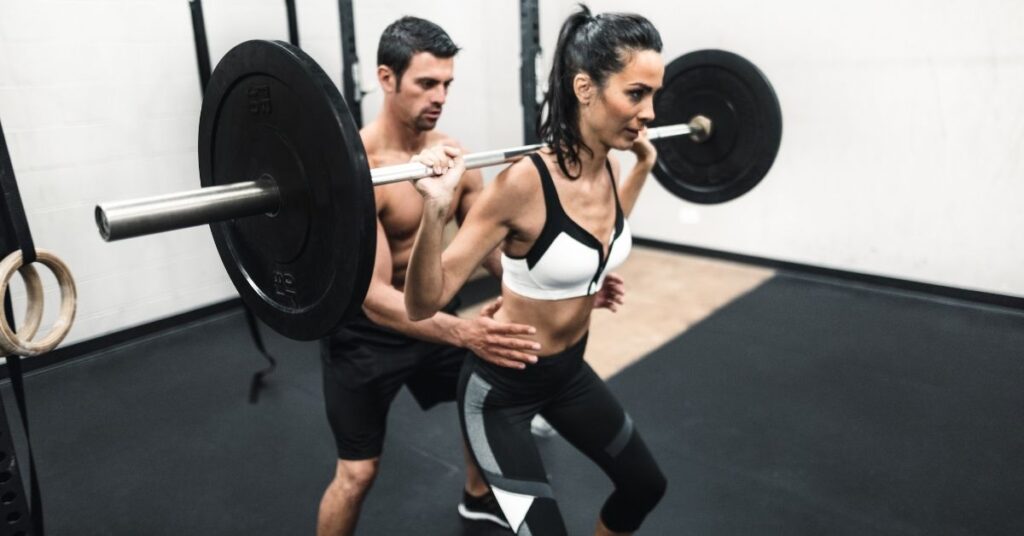
If performed correctly and with the right resistance level, overhead squats are suitable for most people.
This full-body exercise requires coordination, control, strength, mobility, and stability in all major joints and muscles.
To get used to the movement, you can significantly decrease the weight you use for a traditional squat or use a broomstick or PVC pipe to reduce your initial effort.
You can check yourself in the mirror and see any common errors.
Reduce your range of motion, and concentrate on stabilizing your shoulders and core as you develop more mobility through your hips, shoulders, and ankles.
Stop the exercise if you feel any shooting or sharp pains.
10 Overhead Squat Alternatives
You can always do other variations if you feel more comfortable performing squats or lunges.
10 Overhead Squat Progression:
Beginner to Advanced
These are my top 10 exercises for overhead squatting from beginner to expert:
- Body Weight Air Squat
- Wall Facing Squat
- Waiters Walk / Hold
- Single Arm Overhead Press & Band Squat
- Push the Neck Push Grip
- Scotts Press
- Kettlebell Overhead Squat
- Overhead Squat
- Close Grip Overhead Squat
- Hanging Weight OH Squat
This article will explain how each exercise is performed and how it can help you progress to the highest possible overhead squat.
It will take you from beginner to advanced overhead.
These exercises, which are listed alphabetically from beginner to advanced and designed to improve your overhead squat mobility as well as stability and strength, are listed below.
Ability.
#1 Body Weight Air Squat
Everybody does a version of the bodyweight sit-up squat at least once a day.
It is important to ensure that our bodyweight squats are solid before we can overhead squat with a weighted object above our heads.
Any faults in our body weight will be magnified if we have a weight above our heads.
Perfecting your bodyweight air squat is a great place for you to begin.
- Position your feet slightly wider than the hips.
- Toes can have a slight twist.
- Lift your arms in front of you to maintain balance.
- Start the squat by bringing your hips back and allowing your knees to move forwards.
- Move with your knees over your toes.
- Keep your heels on the ground.
#2 Wall Facing Squat
For those who want to practice holding your arms above your head while in the overhead squat position, the wall-facing squat is an excellent exercise.
This exercise will provide valuable feedback on your upper body mobility and help you improve it before you add load.
This exercise is harder than the air squat because you must keep your back extended while squatting.
As your mobility improves, you can use the wall to support you as you start or as a reference point.
- Take a squat position and lift your arms above your head.
- You can imagine you’re holding a barbell, or you could hold a real PVC pipe in your hand.
- Move away from the wall, and get closer to the wall with each rep.
- Continue this way until you have reached your maximum squat depth.
- Keep your technique consistent and your heels on the ground.
- For beginners, the wall may help them stand upright for a while until they have the back strength to move unsupported.
#3 Waiter’s Carry
It is important to prepare your body for lifting weights safely and effectively.
Stability is required for the shoulder joint.
This stability can be achieved by activating all of the small and large muscles surrounding what otherwise would be an inherently unstable joint.
This can be trained with the waiter’s hold.
- Use both your hands to lift a plate in an extended overhead position.
- Lock your elbow.
- Start walking with your arm raised overhead.
#4 Band Squat With Single Arm Overhead Press
It is important to practice the bottom position of the squat before you attempt to do a squat using a weight that is already above your head.
This will get you to squat with a weight above your head.
It is also a great way to increase your mobility in your ankles and hips.
- A thick resistance band should be placed around your midsection.
- This will allow you to remain in your squat throughout your set.
- Make sure you secure the resistance band around an immovable object for safety.
- Reach the bottom of your squat.
- Push a dumbbell overhead from your squat position.
- Alternate pressing on the right and left.
- Keep your chest high and your torso straight throughout every press.
#5 Snatch Grip Behind The Neck Overhead Press
Before overhead squatting, you need to ensure that the barbell is in the right overhead position.
This is an excellent exercise to learn how to safely and effectively snatch the neck push press.
This also helps to keep your shoulder stable.
- Position the barbell on the upper traps of your body and remove the barbell from the rack.
- Stand with your feet under your hips and walk three steps back from the rack.
- Your hands should be in a wide snatch grip.
- You can use the markings on the bar to help you decide how wide your grip should be.
- Your ability to press directly above your head will determine how wide your grip should be.
- You can hold the barbell in the middle of your body if you have trouble holding it.
- Move your elbows so that the bar is under you.
- You can create a dip drive motion with your hips bent and knees bent.
- Keep your torso straight.
- As the barbell gets heavier, this will provide the momentum necessary to push the barbell upwards.
- When you can lift more weight overhead, you can transform the dip drive into a dipping drive and drop’, also called a push-jerk.
#6 Snatch Grip Bottom Press
Snatch grip bottom presses are great for strengthening your core muscles by pressing the barbell overhead in a static squat position.
This challenging movement challenges mobility at the ankle, knee, hip, and shoulder joints.
It also requires you to hold your torso upright (unsupported).
- Place a PVC pipe or barbell over your upper traps.
- Reach the bottom of your squat.
- Pull your upper back muscles tight and place your elbows below the barbell.
- Lift the barbell up high, keeping your back straight.
- Lift the barbell and continue.
#7 Kettlebell Overhead Squat
The overhead kettlebell squat is an excellent exercise to improve shoulder stability.
It also allows you to begin the overhead squat with the load.
Suppose you do not have the upper body mobility to support a barbell above your feet.
In that case, this exercise can be very helpful.
- Push or strictly press the kettlebell overhead while your elbow is extended.
- Use your shoulders to keep an overhead position.
- Start the squat by keeping your elbow out of the way during the squat.
- Before moving on to the double-arm overhead squat, master the single-arm kettlebell overhead squat. This is a more difficult progression.
#8 Barbell Overhead Squat
These 7 exercises will give you a solid foundation in mobility and strength so that you can overhead squat with the barbell.
However, I recommend warming up with a PVC pipe and moving to an empty barbell before adding more load.
This will allow your muscles and brain to warm up.
Over a decade of coaching this movement, I have seen athletes improve their overhead squat abilities with each set.
This is simply because their brain gives them feedback to help them calibrate and adjust their positions.
To overhead squat using a barbell
- Push press, strict press, or push press the bar to your overhead position starting behind the neck.
- You should have a firm grip on the barbell.
- Engage your shoulder and lat muscles to create a stable shoulder.
- You can use this cue to move your armpits forward or inwardly while you grip the bar tightly
- As you lower yourself into the squat, keep your body straight.
- You should lower yourself to maintain complete control over the bar and your body.
- Press the bar up, keeping your elbows locked during the movement.
#9 Close Grip Overhead Squat
You can progress to the more advanced close grip overhead squat as your mobility, and overhead squat abilities improve.
Although it is similar to the overhead squat, your grip will be narrow.
- Lifters with good mobility can perform the overhead squat with a smooth grip and hand placement just outside the shoulders.
- An exceptional lifter may be able to place their hands near one another or cross over on the barbell to maintain an upright overhead squat position and squat depth.
#10 Hanging Weight Overhead Squat
Hanging weight overhead squat is achieved by attaching weight plates or kettlebells with resistance bands to the barbell.
Because of the instability caused by moving objects, overhead squatting is made more difficult.
This exercise will test your shoulder strength and stability as you do the squat.



